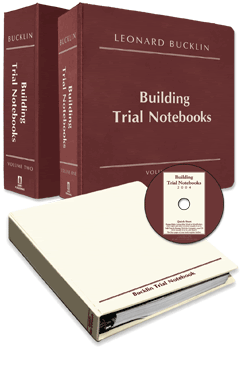There’s a Black Box in your client’s car
 This is a PowerLitigation™ article of Leonard Bucklin. This article was adapted for LawyerTrialForms™ from his multi- volume text of discovery, litigation, and trial advice and tactics, titled Building Trial Notebooks. Bucklin is a Fellow of the International Academy of Trial Lawyers, limited to 500 top trial lawyers in the U.S, a member of the Million-Dollar Advocate’s Forum (for plaintiffs work), and recommended in Best’s Recommended Attorneys (for defense work).
This is a PowerLitigation™ article of Leonard Bucklin. This article was adapted for LawyerTrialForms™ from his multi- volume text of discovery, litigation, and trial advice and tactics, titled Building Trial Notebooks. Bucklin is a Fellow of the International Academy of Trial Lawyers, limited to 500 top trial lawyers in the U.S, a member of the Million-Dollar Advocate’s Forum (for plaintiffs work), and recommended in Best’s Recommended Attorneys (for defense work).
Bucklin’s multi-volume, discovery, litigation, and trial advice and text is available through James Publishing
There’s a Black Box in your client’s car — EDR
By Leonard Bucklin
Most motor vehicles now contain a “black box” -an “Event Data Recorder (EDR). Jurors know that all airplanes have a “black box” (flight data recorder) which provides data about the last moments before a crash. Do you know what pre-crash driver-operation data is recorded in the “black boxes” (the EDRs) in cars and trucks?
The EDR can have the critical information that may win or lose the lawsuit. The EDR can probably answer questions such as: was the driver’s foot on the gas or the brake? How long was the foot on the brake? What was the speed of the vehicle before impact? Were the driver and passengers wearing their seatbelts?
TIP: Always determine if the adversary’s vehicle had an event data recorder or electronic control module. If the adversary has disposed of the vehicle without telling you, think of a motion for spoliation of evidence. On the other flip side, you may be accused of spoliation of evidence if you allow disposition of your own client’s vehicle before the data from the EDR or ECM in your client’s vehicle has been secured.
Judges are admitting EDR data into evidence, even in criminal trials. For example, in Phoenix, Arizona in 2005, newspapers reported a Roman Catholic bishop was convicted in a hit-and-run accident where the EDR evidence showed that he had braked before an impact, thus indicating he had seen the pedestrian he hit, even though he testified he had not seen anything and did not realize that there was anything in his way or any reason to slow down or stop at the accident scene. Another example: EDR data from a car in Florida showed the vehicle was traveling at 144 mph before it struck another vehicle, killing two passengers. The EDR data was used to convict the driver of manslaughter. Mantos v. Florida, 899 So. 2d 403 (2005).
If the car has an EDR, what’s in the EDR?
The EDRs in cars are normally a part of the airbag control module. (That is because EDRs were originally installed for manufacturers’ to prove that their airbags deployed as designed). The type of EDR connected to the airbag control module, which provides data before the airbag is deployed, is most often called a “crash data retrieval system.”
Some manufacturers make a point of distinguishing a “crash data retrieval system” from a “motor data retrieval system.” Instead of being a part of the airbag control module, a motor data recorder in the car is designed as a part of the motor’s operating system, for the primary purpose of letting mechanics find a problem in the operation of the motor. But the motor data retrieved is there not only to help the mechanics, but also to help the manufacturer in litigation, so the system may be designed to have information about what the driver did before a crash. Both a crash data retrieval system and a motor data retrieval system are “event data recorders” (EDR), and both can help in a vehicle accident investigation.
EDRs do not record conversations. Car EDRs don’t keep a running average of how fast you drive. They don’t record whether you come to a complete stop at the last stop sign a minute before the crash. Event Data Recorders in cars only capture the crash data the car manufacturer wants for its own purposes. Typically, the car manufacture only wants crash data limited to the few seconds before, during and after a crash. Most car EDRs do not capture any data unless there is a collision that is severe enough to cause the airbag to deploy. Yet, still, the limited data captured is vital information about the crash.
There are no industry guidelines as to what EDRs in cars should contain. Different manufacturers record different information. For example, the GM devices record vehicle speed, engine speed, brake application, throttle position and whether the seatbelts were fastened. Most commonly EDRs typically record about five to twenty seconds worth of data on four key items: speed (e.g., how far the accelerator is depressed, engine speed, engine RPMs), whether the brakes are engaged (sometimes the point before the impact that the brakes were applied), whether the driver and passengers were wearing seat belts, and whether and when the airbags deployed.
Some EDRs in recent model vehicles can gather information from frontal, side, rear, and rollover impacts. The original EDRs in GM and Ford vehicles only collected information from frontal and rear impacts. But again, because the manufacturer is interested in deployment of air bags, and vehicles now have side air bags, data on side impact crashes can now be downloaded from nearly all 2004 and later GM vehicles with side air bags and some 2001 and later Ford vehicles.
In 2006, the National Highway Transportation Safety Administration issued a rule requiring that after 2011, if a car does have an EDR, then the EDR must record specified types of data. (Note: the NHTSA rule does not require vehicles to have EDRs, only what they must record if there is an EDR.) See National Highway Traffic Safety Administration, Final rule – event data recorders; 49 CFR Part 563, Docket No. NHTSA-2006-25666. Vol. 71 Federal Register, No. 166, August 28, 2006, p.50998-51048. The NHTSA final rule requires the following data. It’s a good checklist to use when asking your expert, or the opposing exert, what data was available in the EDR.
- Speed vehicle was traveling
- Engine throttle (was the accelerator pressed?)
- Brake use (was the brake applied?)
- Change in forward crash speed
- Maximum change in forward crash speed
- Time from beginning of crash at which the maximum change in forward crash speed occurs
- Ignition cycle, crash (number of times the engine had been started prior to the crash)
- Ignition cycle, download (number of times the engine had been started prior to downloading the EDR data)
- Safety belt status, driver
- Frontal airbag warning lamp, on/off
- Driver frontal airbag deployment, time to deploy for a single stage airbag, or time to first stage deployment for a multistage airbag
- Right front passenger frontal airbag deployment, time to deploy
- How many crash events?
- Time between two crash events, if applicable
- Did the EDR complete the recording?
Some manufacturers have EDRs capable of logging more detailed vehicle information. The NHTSA final rule requires that if a manufacture chooses to have an “advanced EDR” then the device must also record sideways acceleration, forward acceleration, rearward acceleration, engine speed, driver steering input, right front passenger safety belt status, engagement of electronic stability control system, antilock brake activity, side air bag deployment time for driver and right front passenger, and seat track positions for both the driver and right front passenger.
Most, but not all, cars have EDRs.
The best data on the percentage of cars on the road that have EDRs comes from a 2005 study by the National Highway and Traffic Safety Administration. NHTSA found 64 percent of 2005 model passenger vehicles had EDRs. Since 2005 more manufacturers have been installing EDR’s as a routine part of the car design. As a result, the chances today are about two out of three that at least one of the vehicles in an MVA in a lawsuit had potentially recoverable electronic data about the collision.
General Motors has had the crash data retrieval EDR modules in all its models since 1999. Ford has had them in all models since 2000. Today, General Motors, Ford, Isuzu, Mazda, Mitsubishi, Subaru, and Suzuki equip all of their vehicles with EDRs. Toyota installs an EDR in half of their vehicles. However, BMW, Daewoo, Honda, Hyundai, Kia, Mercedes, Nissan, Porsche, and Volkswagen don’t have crash data retrieval systems. (Remember what we said earlier: crash data retrieval systems are distinguished from a motor data retrieval system – most cars of any manufacturer now have motor data recorders.)
The existence and type of EDR’s in commercial 18-wheeler truck tractors is a different story. First, it’s not merely a majority that have them: almost 100% of truck tractors have EDRs. Second, importantly, also, truck tractors motor EDRs are more sophisticated, much more reliable, and contain much more data than the EDRs in cars. That’s because the EDRs in cars are only outgrowths of airbag design, whereas truck tractor EDRs are a result of both the manufacturers’ and also fleet owners wanting a record of how drivers operate their trucks over complete long distance trips.
Who owns the data in the EDR?
It is clear that the EDR is part of the vehicle, and the data in the EDR belongs to the vehicle owner. Police, insurers, attorneys, and investigators may gain access to the data with owner consent. Without consent, you will need a court order or a discovery process (typically a federal Rule 34 or 45, or similar state rule, request) to allow access to inspect and download the data from the owner’s vehicle.
Recoverability and usability of EDR data
Data from the EDR may not be recoverable or usable.
Most accident investigators of a professional stature now have a device that can plug a laptop into the EDR and download the information. But if the data is downloaded, it is subject to the same evidentiary problems one has if downloading electronic data from a desktop computer. Was the download performed in a way that insured the accuracy of the downloaded information? Did the download change the original recording, so the copy can be compared to the original? Has the downloaded information been safeguarded from change?
The only public study of how often a vehicle EDR records what it should record shows you cannot expect recovery of EDR information in all cases. The NHTSA reviewed the results of 37 crash tests in vehicles equipped with EDRs and found that the majority of EDRs didn’t record the entire crash event. In addition, during 2002 and 2003, NHTSA field investigators couldn’t retrieve data in about one-third of their attempts. In some cases, the EDR didn’t have any data. In other cases, vehicle damage prevented downloading the data, or technical issues prevented the downloading of data. Hinch, J.; Chidester, A.; Brophy, J.; and Roston, T., The use of EDR technology to support NHTSA’s crash investigation programs. (PowerPoint presentation at the SAE Symposium Highway Vehicle Event Data Recorder, June 2004).
Data from the EDR may be misleading.
Most often, the EDR records wheel speed — which is not necessarily actual speed. An EDR in a car that is flipped on its roof with wheels spinning could record a high rate of speed even though the car is not moving. One widely-cited example of bad EDR data is a case in which a driver on an icy road hit another vehicle, killing two people. The driver was accused of vehicular manslaughter. The car’s EDR reported from the speed of the wheel revolutions on the icy road in the last five seconds before the crash that the car was traveling between 51 and 60 mph at the time. However, even the police accident reconstruction found that improbable and more likely the speed of the vehicle when brakes were applied (as opposed to the speed of the spinning wheels on the icy road) was between 30 and 40 mph.
Truck engine black box (ECM ) is better than car EDR.
All heavy truck engines today have an Electronic Control Module (ECM) that provide much more trip information than the EDR’s of automobiles. That’s because ECMs on trucks originally were designed to be standard equipment on all diesel engine fuel injection systems. The next step was to add a vehicle speed sensor to allow the ECM to provide the cruise control, electronically, with no throttle linkage. From there it was a fleet sales step to add additional sensors and programming to track driver performance. Tracking driver performance on the total trip was a feature attractive to trucking companies. Reports that shows trip times, speeds at various times, average cruise speeds, gear engagement times, total idle time and the existence and number of hard stops can help a company save fuel and engine wear and tear. Those records help a company to decide whether to retain one driver instead of another. Hence, today large trucking companies use ECMs to monitor vehicle maintenance, speed, resource management, and driver actions.
The truck driver action recorded is not only for the last trip, but for many trips. Data, if not deleted, can show months’ worth of measurements, such as the time spent in each speed range or gear – habits that make up regular driving style, not just what happened on one trip. So, if you are
a plaintiff’s attorney wondering if you can accuse the company for negligently failing to control a driver who always exceeds highway speed limits and always falsifies his driver’s log as to how many hours he spend driving and resting during the trip — the ECM data for the last month will probably give you an answer.
All truck engine makers provide one or more software packages for downloading driver performance information onto a PC. Getting the data requires an RP1210-compliant adapter, which your truck expert should have, and which will access the information according to electronic protocols that are standard on all trucks, such as SAE J1587 and J1939.
If you want to impress the witness and use the name of the ECM in the truck involved, the common names are:
- (Caterpillar) “Cat Driver Information Display”; (Cummins) Road Relay;
- (Mack) V-MAC;
- (Detroit Diesel Corporation) DDEC; and
- (Freightliner) Data Logging Unit or DLU.
Don’t be accused of malpractice or spoliation of the EDR / ECM
As a lawyer handling a motor vehicle accident, you may be accused of malpractice if you fail to get available electronic evidence from the adversary’s vehicle.
TIP: Always determine if the adversary’s vehicle had an event data recorder or electronic control module. If the adversary has disposed of the vehicle without telling you, think of a motion for spoilation of evidence.
On the other flip side, you may be accused of spoliation of evidence if you allow disposition of your own client’s vehicle before the data from the EDR or ECM in your client’s vehicle has been secured. Cases are now coming to the trial courts where one side claims (1) their version of the facts would be shown as true by the adversary’s EDR / ECM; and (2) the adversary’s vehicle was sold or the EDR / ECM evidence lost by actions of the adversary (usually selling the vehicle for salvage); and (3) the adversary or her attorney should be sanctioned for spoilation of evidence
WARNING: Never, never, never, allow your client or an insurer to dispose of your client’s vehicle until the adversary has had the opportunity to inspect the vehicle. Always notify the adverse insurer or attorney (by certified mail) that your vehicle is available for inspection until a specified date when it will be sold for salvage without
further notice.

